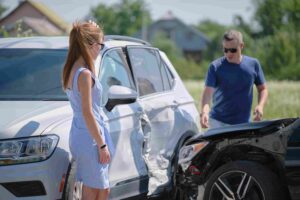T-bone collisions occur when the front of a vehicle collides with the side of a different vehicle. Sometimes, accidents like this are called side-impact collisions because of where the impact occurs.
Accidents like this are most commonly seen at intersections but can occur any time a vehicle crosses a street or road.
If you are involved in a T-bone accident, you may wonder who is at fault and what rights you have to compensation. At Jonathan Perkins Injury Lawyers, our experienced Connecticut car accident attorneys can answer your questions and help you file a claim.
Learn more about determining liability in T-bone accidents here.
Determining Fault in T-Bone Accidents
With accidents like these, liability is not determined by who T-boned the other vehicle. Instead, it is based on which car had the right to move through the intersection when the accident occurred.
Only one vehicle has the right of way at a time. When a T-bone collision occurs, one vehicle will have the right of way, and the other will violate this. The car that did not have the right of way is considered at fault for a T-bone accident in Connecticut.
While this is true, the vehicle with the right of way may be considered partly at fault if they were unaware of what the other vehicle was doing.
Unfortunately, most T-bone accident scenes do not leave evidence regarding who had the right of way, which makes determining liability challenging.
In these accident cases, the fault is often determined by what the drivers and witnesses say occurred. If both drivers state they had the right of way, it comes down to whose story is more credible.
Our skilled car accident attorneys in Connecticut will use the evidence available to show the other driver was at-fault in your accident and that you should receive compensation for your injuries and losses.
Some of the evidence that is used includes the following:
- Police reports
- Medical records
- Photo and video evidence
- Statements from witnesses
This evidence must be collected quickly. Because evidence can be lost or destroyed when others arrive at the accident scene, you should do anything possible to collect related evidence.
Negligence and the Driver’s Requirement to Act with Reasonable Care
Evidence presented during car accident trials is considered based on the “preponderance of evidence.” If negligence is suspected, the victim (with help from their attorney) must show they sustained damages.
It must also be proven that the at-fault driver breached their duty by not abiding by the “reasonable standard of care.” Beyond that, it must be proven that the breach was the main cause of the damages.
Some of the most common causes of Connecticut T-bone accidents include the following:
- Braking, steering, or other part or mechanical failures
- Failing to yield
- Driving while impaired by alcohol or drugs
- Not stopping at an intersection
- Miscalculating oncoming traffic while turning right
- Running a red light
- Turning across multiple lanes of traffic
- Texting or talking on the phone while driving
- Aggressive or reckless driving
Common Injuries Seen in T-Bone Accidents
While T-bone accidents can cause many types of injuries, some of the most commonly seen include the following:
Injuries to the Face
When the airbags deploy, they can cause facial injuries, like fractures, burns, and injuries to your scalp. If the glass breaks, it can cut exposed skin. Common facial injuries seen include:
- Scrapes and abrasions
- Cuts and lacerations
- Bodily contusions and bruises
Broken Bones
You may also experience broken bones in a T-bone car accident. Common bones affected include the hands, wrists, legs, and arms. The force of the impact may also cause the door to collapse, which can cause the vehicle to cave in and lead to head trauma and internal injuries.
Spinal Injuries
Spinal injuries are not uncommon in T-bone accidents. That is because a compression injury can occur. The force of the impact is what causes these.
Internal Injuries
When a T-bone accident occurs, the impact of the collision can turn steering wheels, door handles, and other parts into dangerous objects. They can lacerate the spleen, liver, and kidneys.
Let Our Skilled Attorneys Help with Your T-Bone Accident Claim
If you are involved in a T-bone accident, contact our team at Jonathan Perkins Injury Lawyers. We can review your case and work to protect your rights.
The first step is to call our Connecticut personal injury lawyers to schedule a free consultation. We will aggressively fight for your rights to the maximum compensation for your injuries and losses.
Read More

